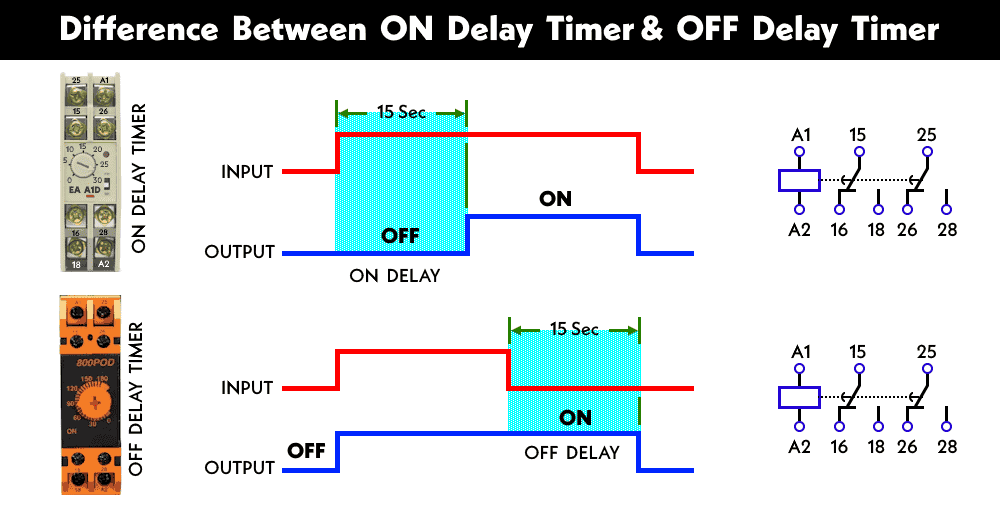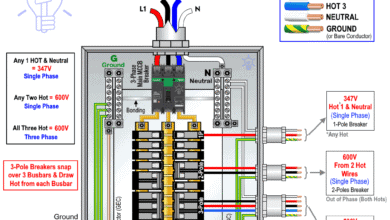Difference Between ON Delay and OFF Delay Timer
Comparison Between OFF Delay and ON Delay Timers
Mechanical timing relays and delay timers serve the purpose of delaying the opening or closing of contacts for circuit control. They operate in a similar manner to control relays, with the key distinction being that specific contacts within the timing relay are designed to activate after a predetermined time interval following the energization or de-energization of the coil.
By utilizing timers, a wide range of operations within a control circuit can be initiated and halted automatically at varying time intervals. In the following post, we will discuses the main differences between ON Delay and OFF Delay Timers for circuits control and PLC logic control.
ON Delay Timer
An ON delay timer, also known as a delay-on timer, is a type of timer used in control systems and electrical circuits. It is designed to introduce a delay between the activation of an input signal and the activation of an output signal. In other words, after the input signal is turned on, there is a specific duration before the output signal is activated.
The ON delay timer is commonly used in various industrial applications and automation systems where timing functions are required. It allows for controlling the duration of an operation or providing a delay before energizing a circuit or starting a process.
The working principle of an ON delay timer is as follows. When the input signal is activated, the output signal remains inactive for a predefined period called the delay time. After this delay time elapses, the output signal is then activated. This delay allows for proper synchronization and coordination between different components or systems.
The delay time in an ON delay timer can be set to a specific duration using adjustable settings or pre-determined time increments. This enables the user to customize the timing functionality according to the requirements of the particular application.
Overall, ON delay timers are useful in scenarios where a delay is necessary between the activation of an input signal and the activation of an output signal. They provide control and flexibility in industrial processes, allowing for precise timing and coordination between different components or systems.
OFF Delay Timer
An OFF delay timer is a type of timer used in control systems and electrical circuits. It is designed to introduce a delay between the removal of an input signal and the deactivation of an output signal. In other words, after the input signal is turned off, the output signal remains active for a specific duration before it is switched off.
The OFF delay timer is commonly used in various industrial applications and automation systems where timing functions are required. It allows for controlling the duration of an operation or providing a delay before de-energizing a circuit or shutting down a process.
The working principle of an OFF delay timer is straightforward. When the input signal is activated, the output signal is also activated simultaneously. However, when the input signal is turned off, the output signal remains active for a predefined period called the delay time. After this delay time elapses, the output signal is finally deactivated.
The delay time in an OFF delay timer can be set to a specific duration using adjustable settings or pre-determined time increments. This enables the user to customize the timing functionality according to the requirements of the particular application.
Overall, OFF delay timers are useful in scenarios where a delay is necessary between the removal of an input signal and the deactivation of an output signal. They provide control and flexibility in industrial processes, allowing for precise timing and coordination between different components or systems.
Differences Between OFF Delay & ON Delay Timers
The main difference between an OFF delay timer and an ON delay timer lies in their respective timing functions and the behavior of the output signal in relation to the input signal. Here are the key distinctions:
Timing Function:
OFF Delay Timer: In an OFF delay timer, there is a delay between the removal of the input signal and the deactivation of the output signal. After the input signal is turned off, the output signal remains active for a specific duration before it is switched off.
ON Delay Timer: In an ON delay timer, there is a delay between the activation of the input signal and the activation of the output signal. After the input signal is turned on, the output signal remains inactive for a specific duration before it is switched on.
Output Signal Behavior:
OFF Delay Timer: With an OFF delay timer, the output signal is initially activated when the input signal is activated. The output signal remains active even when the input signal is turned off. It is only after the delay time elapses that the output signal is deactivated.
ON Delay Timer: With an ON delay timer, the output signal is initially inactive when the input signal is activated. The output signal remains inactive for the delay time after the input signal is turned on. After the delay time elapses, the output signal is activated.
In summary, an OFF delay timer introduces a delay between the removal of the input signal and the deactivation of the output signal, while an ON delay timer introduces a delay between the activation of the input signal and the activation of the output signal. The specific timing behavior and application requirements determine which type of timer is most suitable for a given scenario.
Comparison Between ON Delay and OFF Delay Mechanical Relay Timers
Use an ON delay timer when you need to activate an appliance after a specific time. The appliance will be off during the specified time. Use an OFF delay timer when you need to activate an appliance for a specific time and then shut it down after the specified time.
Related Posts:
- Difference Between 120V and 240V/230V AC Power Supply
- Difference Between 50 Hz and 60 Hz Frequency System
- Difference Between Solid-State Relay and Electromechanical Relay
- Difference Between HP & BHP? Horsepower vs Brake Horsepower
- Difference between Electron Current and Conventional Current
- Stranded Wire vs Solid Wire. Which One is Best and Why?
- Difference between Synchronous and Asynchronous Motor
- Difference Between Single Phase and Three Phase Power Supply
- Difference Between Grounding, Earthing and Bonding
- Difference Between Current and Voltage
- Difference between AC and DC (Current & Voltage)
- Difference Between GFCI and AFCI







